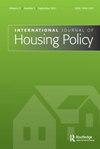Structures of power and inequality
IF 2.6
2区 经济学
Q3 ENVIRONMENTAL STUDIES
引用次数: 0
Abstract
In this thoughtful and scholarly book, Paul Watt offers an account of London’s local authority housing policies that is informed mainly by the experiences of council tenants who have been subjected to ‘regeneration’ policies over the period 2007–2019. This period is significant as it included the aftermath of the global financial crisis when local authorities in London struggled to manage government-imposed austerity spending cuts and deliver essential services in housing, education, and aged care. Estate Regeneration and its Discontents consists of three parts: policy analysis and the research context, which critiques longstanding sociological interpretations and the history of regeneration; estates before regeneration which considers the significance of place for residents; and living through regeneration, where Watt explores the views of tenants during the implementation and aftermath of interventions. Watt is in favour of estate regeneration to address the years of under-investment, but he argues that it needs to maintain or increase the public housing stock and preserve neighbourhood sociality. So, for Watt, though the ostensible rationale for estate-based regeneration was to improve the quality of the residualised housing, it also included an architectural design component the estates were deemed not to meet environmental standards and were poorly integrated into the neighbourhood (p. 80). In practice, what eventuated in London was deeply problematic as many of the regeneration interventions were undermined by privatisation policies, austerity spending cuts and restrictive allocation policies. And yet, as Watt explains, when compared to the private rental market, public housing is valued by many tenants, as it is secure and of better quality. As he explains, public housing provided ‘genuinely affordable and secure homes for over a century to an unusual extent by the standards of most major Western cities’ (p. 4). And in the early 1980s almost one in three of all London’s households − 770,000 − lived in public housing. Yet by 2016, the number of households in public housing was only 444,000. In my review I consider Watt’s analysis under three headings: structures of power and inequality; tenant and activist perceptions; and critical research.权力和不平等的结构
在这本深思熟虑的学术著作中,保罗·瓦特(Paul Watt)介绍了伦敦地方当局的住房政策,这些政策主要是根据2007年至2019年期间遭受“再生”政策影响的市政租户的经历而制定的。这一时期意义重大,因为它包括全球金融危机的后果,当时伦敦地方当局努力管理政府实施的紧缩开支削减,并在住房、教育和老年护理方面提供基本服务。《房地产再生及其不满》由三个部分组成:政策分析和研究背景,对长期以来的社会学解释和再生历史进行了批判;重建前的屋苑,考虑地方对居民的重要性;以及通过再生来生活,在这里,瓦特探索了租户在干预实施和后果期间的观点。瓦特赞成通过房地产再生来解决多年来投资不足的问题,但他认为,这需要维持或增加公共住房存量,并保护邻里社会。因此,对瓦特来说,尽管基于地产的再生表面上的理由是提高剩余住房的质量,但它也包括建筑设计部分,这些地产被认为不符合环境标准,与社区的融合很差(第80页)。在实践中,伦敦最终的结果存在严重问题,因为许多重建干预措施受到私有化政策、紧缩支出削减和限制性分配政策的破坏。然而,正如瓦特解释的那样,与私人租赁市场相比,公共住房受到许多租户的重视,因为它更安全,质量更好。正如他所解释的那样,公共住房在一个多世纪以来提供了“真正负担得起的、安全的住房,以大多数主要西方城市的标准来看,这是非同寻常的”(第4页)。在20世纪80年代初,几乎三分之一的伦敦家庭——77万——住在公共住房里。然而,到2016年,公共住房的家庭数量仅为44.4万户。在我的评论中,我将瓦特的分析分为三个标题:权力和不平等的结构;租户和激进分子的看法;批判性研究。
本文章由计算机程序翻译,如有差异,请以英文原文为准。
求助全文
约1分钟内获得全文
求助全文
来源期刊

International Journal of Housing Policy
Multiple-
CiteScore
5.80
自引率
14.30%
发文量
42
期刊介绍:
The International Journal of Housing Policy aims to be the leading forum for the critical analysis of housing policy, systems and practice from a social science perspective. It is published quartely. We welcome articles based on policy-relevant research and analysis focused on all parts of the world. We especially encourage papers that contribute to comparative housing analysis, but articles on national or sub-national housing systems are also welcome if they contain data, arguments or policy implications that are relevant to an international audience.
 求助内容:
求助内容: 应助结果提醒方式:
应助结果提醒方式:


